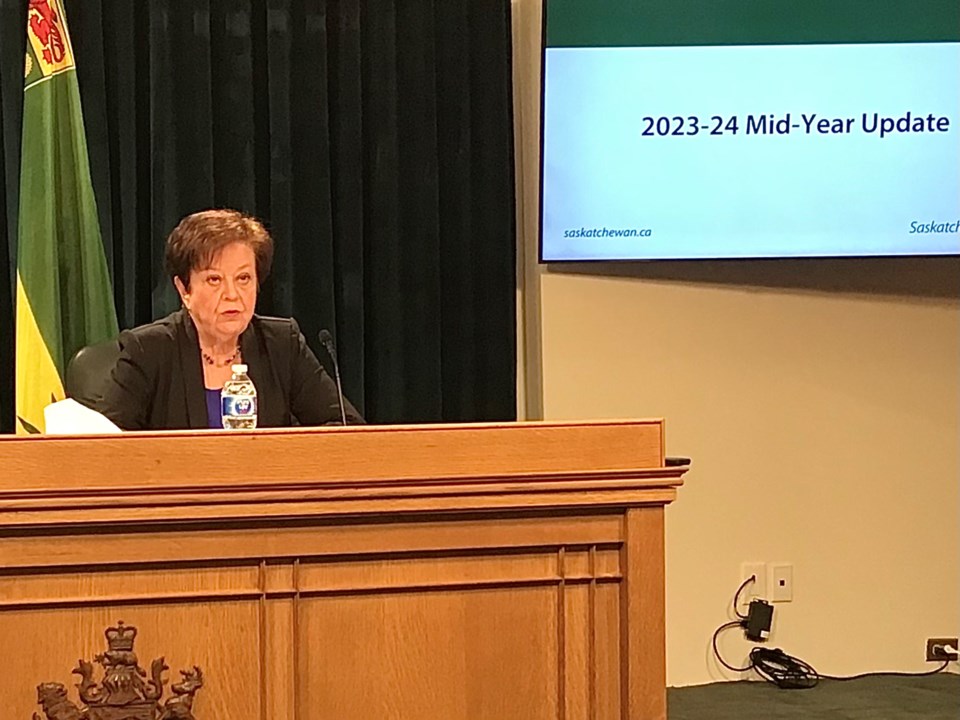REGINA - After a year or so in surplus, Saskatchewan is back in deficit after a summer of drought and lower potash prices.
The province released its mid-year financial update Monday morning, which is forecasting a deficit of $250.5 million at mid-year, down $1.3 billion from the projected $1 billion surplus budget, and down $736.1 million from the first quarter update.
The update presented by Deputy Premier and Minister of Finance Donna Harpauer, who said “two large factors outside the government’s control play into this forecast” — pointing to the change due to drought and potash.
"Despite these challenges, our fiscal picture is solid, more people than ever are living and working in Saskatchewan, and our economy is resilient,” said Harpauer.
In speaking to reporters, Harpauer made it known she did not think this was a structural deficit.
“We’ve had some extreme swings to our budgets in our last few budgets, and none of them would be structural,” said Harpauer. She pointed to extreme events such as the pandemic, global unrest and the catastrophic drought.
“Those are all extreme events that create swings in the budget, but when you look at what is historical averages of revenue coming in and expenses going out, we don’t have a structural difficulty yet. But we do need to watch closely for sure.”
The deficit forecast also would seem to put a crimp into any tax cuts in the 2024 budget. Looking at it it was “not likely” there would be tax cuts, but Harpauer said they were still very early in their budget deliberations and she said they would see where the economy goes.
“Absolutely,” said Harpauer when asked how disappointing it was to be presenting a deficit when a $1 billion surplus had been forecast at budget. “It is disappointing.”
Despite that, Harpauer still pointed to a solid economic picture for the province.
“The strength of the economy, I think, is the positive message here, the still solid position — we are the second lowest of debt to GDP,” said Harpauer. She also said the pension liability alone would cover the deficit. “If that wasn’t in there we’d still be in a surplus position.”
Here are six takeaways from this year’s midyear update:
Potash prices take a hit
A major driver of the deficit has been the impact on potash prices and sales of global market conditions.
"Potash prices and sales have been impacted by challenging global market conditions which have significantly impacted resource revenues,” said Harpauer. It was noted that potash from Russia and Belarus flowed to large markets including China and India, even with Western sanctions in place from Russia's invasion of Ukraine.
Drought was unforeseen
According to the province, higher crop insurance claims from the severe drought that hit parts of the province in summer 2023 was one of the primary drivers of the deficit forecast.
The province is stating this was unforeseen, reducing projected crop production by 20 per cent in 2023, when compared to 2022.
Revenues solid, apart from non-renewable resources
While two major areas are taking a hit, the revenue situation overall continues to look solid.
At mid-year, total revenue is forecast to be up $35.2 million, or .2 per cent, over budget. But that is being offset by a $717.8 million decrease in forecast non-renewable resource revenue compared to budget. It was noted potash prices have declined 28.6 per cent and production is down 5.9 per cent from budget.
Increases of $753 million in forecast revenue are largely from taxation being up $414.7 million including Corporate Income Tax and Provincial Sales Tax. Government Business Enterprise net income is up $204.4 million, Other Own-Source revenue is up $123.1 million, and federal transfers are also up.
Areas seeing revenue declines
But that good news is largely offset by a $717.8 million decrease in forecast for Non-Renewable Resource revenue at mid-year compared to budget, mainly attributable to potash revenue being down $552 million.
Harpauer pointed to prices and production having experienced a significant decrease. The province is pointing to prices having gone down 28.6 per cent and production having gone down 5.9 per cent from budget.
Resource Surcharge revenue is also down $265 million, again driven by lower potash prices and sales. The areas of natural resource revenue seeing increases are oil, up $68 million, and land sales up $42 million.
Expenses up
At mid-year, total expense is forecast to be up $1.3 billion, or seven per cent from budget.
Leading the way is agriculture expense, forecast at $853 million higher than budget largely due to increased crop insurance claims and other support programs.
“I want to be clear, we are not attributing the deficit to producers,” said Harpauer, who said the drawing down of funds must be recorded as an expense.
There is also an increase in education ($270.7 million) and general government expenses ($45.3 million), due to higher expenses in non-cash pension expense in the Saskatchewan Teachers Superannuation Plan and the Public Service Superannuation Plan.
Forecast expense for wildfire response and evacuations are also higher than budgeted.
Debt situation
The gross public debt is forecast to be $31.6 billion at fiscal year-end, or up $709.5 million from budget.
The province is reporting an $800 million increase in Saskatchewan Capital Plan debt, due to previous operating surplus funds no longer being available to support capital spending. The province is saying borrowing is increasing to finance capital, including investment into schools, highways, hospitals and other infrastructure.
But they also are saying their plan to retire up to $1 billion in operating debt in 2023-24 remains unchanged at mid-year. Harpauer pointed to the strong cash balances over the last fiscal year as the reason.
The province also is noting Saskatchewan's net debt as a percentage of Gross Domestic Product is expected to be 13.3 per cent at the end of 2023-24 up from 12.9 per cent, which is second-lowest among the Canadian provinces.
SASKTODAY.ca is Saskatchewan's home page. Bookmark us at this link.





